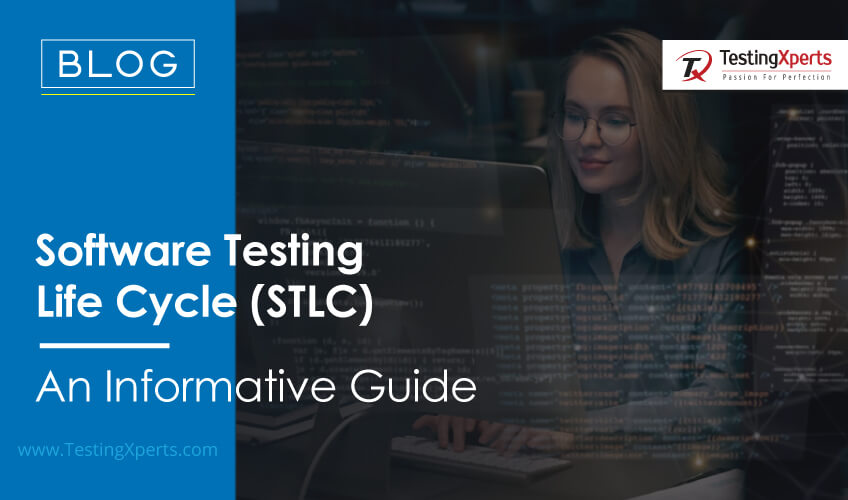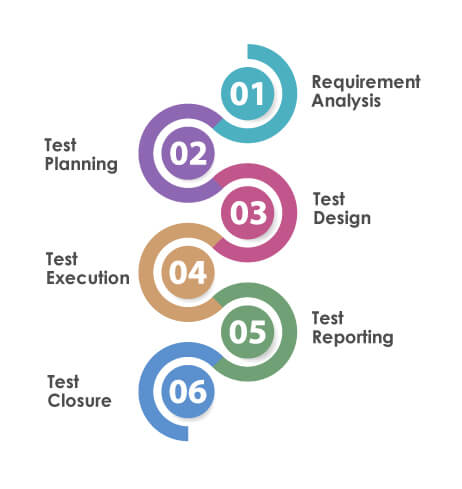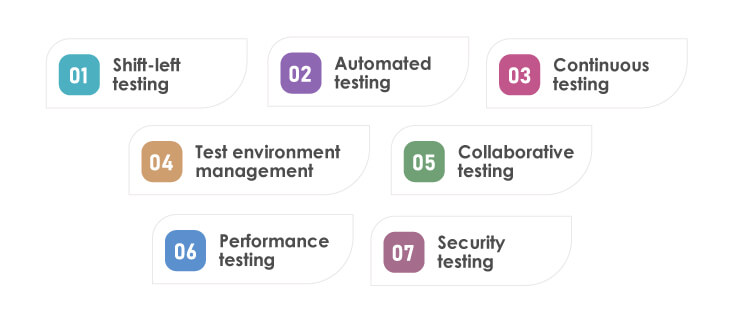Recommended Blogs
Software Testing Life Cycle (STLC) – An Informative Guide

Table of Content:
What is Software Testing Life Cycle (STLC)?
Software Testing Life Cycle (STLC) is a set of steps that defines how testing is planned, designed, executed and closed in the software development life cycle testing process. It’s not just a phase but a process that starts as soon as requirements are defined and ends with test closure.
Software Testing Life Cycle (STLC) is a set of steps that defines how testing is planned, designed, executed and closed in the software development life cycle testing process. It’s not just a phase but a process that starts as soon as requirements are defined and ends with test closure.
Each step in STLC ensures that the application meets both functional and non-functional requirements. From planning test strategy to executing cases and tracking defects, STLC helps QA teams to detect issues early and improve product quality.
The software testing life cycle phases are:
- Requirement Analysis
- Test Planning
- Test Case Design
- Test Environment Setup
- Test Execution
- Test Reporting and Closure
By following these stages, companies can reduce defects, speed up time to market and ensure a stable release. STLC acts as a quality gate between development and delivery, so software teams can ship with confidence.
What is the Role of STLC in SDLC?
STLC plays a major role in the bigger picture of software development life cycle testing. While SDLC defines the overall path from requirement gathering to deployment, STLC ensures every step is tested for quality, reliability and performance.
Think of it this way. SDLC builds the product and STLC checks if it actually works as intended. It provides a structured testing workflow that runs in parallel with development. From requirement analysis to planning, executing tests and closing with insights, STLC ensures defects are caught early and resolved quickly.
By integrating STLC into SDLC, teams can validate both functional and non-functional aspects of the application. This leads to fewer bugs in production, better user experience and faster release cycles.
In short, STLC brings discipline and accountability to software development life cycle testing, so teams can build with confidence and deliver with consistency.
STLC vs. SDLC: Key Differences

Here are seven key differences between the two models:
Purpose:
The primary purpose of SDLC is to guide the development of software from its inception to its deployment, while STLC is focused on testing and validating the software during the development cycle.
Activities:
SDLC consists of a series of stages or phases, such as requirement gathering, design, coding, testing, deployment, and maintenance. In contrast, STLC is focused specifically on testing activities, including test planning, test design, test execution, and defect management.
Scope:
SDLC covers the entire software development process, from requirements gathering to maintenance, while STLC is focused only on the testing phase.
Deliverables:
SDLC produces a variety of deliverables, including project plans, design documents, source code, and user manuals. In contrast, STLC produces test plans, test cases, test reports, and defect reports.
Approach:
SDLC is a more comprehensive approach to software development, while STLC is a narrower and more focused approach to testing.
Timing:
SDLC is an end-to-end process that spans the entire software development cycle, while STLC is a subset of SDLC that focuses only on the testing phase.
Flexibility:
SDLC is more flexible and can be adapted to different software development projects, while STLC is a more rigid process that is focused solely on testing activities.
Overall, SDLC and STLC are two complementary processes that work together to ensure the successful development and deployment of software. While SDLC covers the entire software development process, STLC focuses specifically on testing and validating the software during the development cycle.
66 Key Phases of STLC

There are several phases involved in the STLC, and the key phases are:
Requirement Analysis:
In this phase, the software requirements are analyzed and documented. This involves understanding the client’s requirements, identifying the scope of the project, and determining the testing objectives.
Test Planning:
In this phase, the testing team prepares a test plan that outlines the approach, resources, and schedule for the testing process. This includes identifying the testing types, techniques, tools, and environments to be used, as well as defining the roles and responsibilities of the team members.
Test Design:
In this phase, the testing team designs the test cases, scenarios, and scripts based on the requirements and test plan. This includes identifying the input data, expected outcomes, and validation criteria for each test case.
Test Execution:
In this phase, the testing team executes the test cases, scenarios, and scripts according to the test plan. This involves running the tests and recording the results, as well as identifying and reporting defects.
Test Reporting:
In this phase, the testing team prepares test reports that summarize the testing process and results. This includes documenting the test cases executed, defects found, and overall quality of the software product.
Test Closure:
In this phase, the testing team evaluates the testing process and the software product against the testing objectives and criteria. This involves reviewing the test reports, identifying areas for improvement, and making recommendations for future testing activities.
Best Practices of STLC for DevOps-driven Businesses

With the emergence of DevOps-driven businesses, the role of STLC has become even more critical. Here are seven best practices of STLC for DevOps-driven businesses:
Shift-left testing:
The shift-left approach is a DevOps practice that involves testing early in the software development life cycle (SDLC). STLC should be aligned with the shift-left approach, where testing starts in the requirements gathering phase itself. This helps identify defects and issues early in the process, reducing the cost of fixing them later.
Automated testing:
DevOps-driven businesses rely heavily on automation, and STLC is no exception. Automated testing helps reduce the testing time and allows for frequent and faster releases. Automated tests should be created as part of the development process, and the tests should be integrated with the CI/CD pipeline.
Continuous testing:
Continuous testing is an integral part of the DevOps pipeline. It involves running automated tests at every stage of the pipeline, including development, testing, staging, and production. Continuous testing helps identify defects and issues early, allowing for quicker resolution.
Test environment management:
Test environment management is crucial in DevOps-driven businesses as it involves multiple environments, including development, testing, staging, and production. It is essential to manage the test environment effectively, ensuring that it is identical to the production environment.
Collaborative testing:
Collaboration between developers, testers, and operations teams is crucial in DevOps-driven businesses. Collaborative testing involves working together to identify issues and defects, enabling quicker resolution.
Performance testing:
Performance testing is essential in DevOps-driven businesses as it helps ensure that the application meets the performance requirements. Performance testing should be automated, and the tests should be run continuously to ensure that the application can handle the expected load.
Security testing:
Security testing is essential in DevOps-driven businesses as it helps ensure that the application is secure. Security testing should be automated, and the tests should be run continuously to identify security vulnerabilities early.
In summary, DevOps-driven businesses require STLC practices that are aligned with the shift-left approach, automated, continuous, collaborative, and include performance and security testing. Implementing these best practices can help ensure that software products meet the high standards required in DevOps-driven businesses.
Conclusion
STLC, or Software Testing Life Cycle, is a structured approach to software testing that helps ensure the quality of software products before they are released to the market. It involves a series of testing phases, each with its own set of objectives and deliverables. By following a well-defined testing process, STLC helps ensure that software products are thoroughly tested and free from defects before they are released to customers.
This leads to higher customer satisfaction and fewer issues with the product in the long run. Hence, it is evident that following an STLC approach to software testing can help digital businesses improve the quality of software products, reduce costs, increase efficiency, promote better collaboration, and ensure compliance with industry standards and regulations.
How TestingXperts Helps Digital Businesses with Software Testing
TestingXperts (Tx) is one of the top 5 pure-play software testing services providers globally. Tx has been chosen as a trusted QA partner by Fortune clients and ensures superior testing outcomes for its global clientele. We have rich expertise in enabling end-to-end testing services for global clients across various industry domains like healthcare, telecom, BFSI, retail & eCommerce, etc. With our domain knowledge and with over a decade of pure play testing experience, the company has been serving the global clientele with high-quality next-gen testing services to deliver superior solutions to clients.
TestingXperts Differentiators
• Industry thought leadership in QA aligning to latest frameworks, like CMMi, ISO, and TMMis.
• End-to-end testing services experience with expertise on all industry-leading tools.
• Pre-designed TCoE framework with a focus on building test assets for processes, templates, in-house accelerators, domain and technology knowledge, IP etc.
• Dedicated test labs in the US, UK, and India to meet your needs based on your requirements offer a compelling value proposition.
• In-house frameworks, accelerators, and tools that can be readily deployed to set up the TCoE.
• Align seamlessly with your DevOps function, development methodology, and processes.
• Skilled pool of resources and flexibility for quick ramp and ramp down.
FAQs
STLC is a process that defines testing phases from planning to closure. It ensures software is verified, validated and ready for release.
7 steps are requirement Analysis, Test Planning, Test Case Design, Test Environment Setup, Test Execution, Defect Reporting & Retesting, and Test Closure.
6 phases are requirement Analysis, Test Planning, Test Design, Environment Setup, Test Execution, and Test Closure. Some steps are merged for simplicity.
Key principles are: Testing shows the defects, exhaustive testing is impossible, early testing is important, defects cluster, and testing depends on context.
Discover more
Stay Updated
Subscribe for more info
